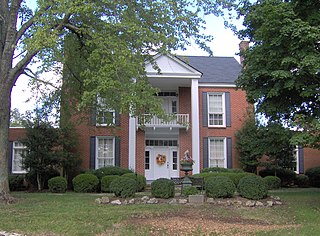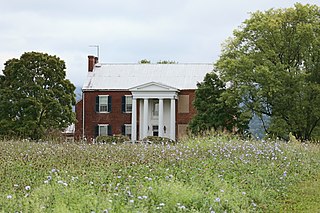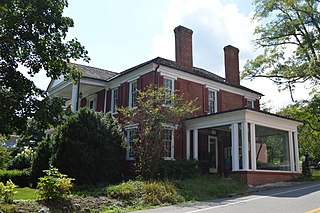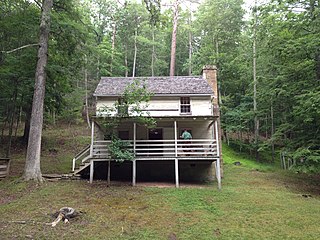
The Wilson-Wodrow-Mytinger House is a complex of three structures, built between the 1740s and 1780s, in Romney, West Virginia. The clerk's office, dating from the 1780s, is the oldest surviving public office building in West Virginia. The kitchen building is the oldest remaining component of the Wilson-Wodrow-Mytinger House and the oldest building in Romney. Throughout its history, the Wilson-Wodrow-Mytinger House has been known as the Andrew Wodrow House, the Mytinger Family Home, and the Mytinger House.

The Sloan–Parker House, also known as the Stone House, Parker Family Residence, or Richard Sloan House, is a late-18th-century stone residence near Junction, Hampshire County, in the U.S. state of West Virginia. It was built on land vacated by the Shawnee after the Native American nation had been violently forced to move west to Kansas following their defeat at the Battle of Point Pleasant in 1774. The building was added to the National Register of Historic Places on June 5, 1975, becoming Hampshire County's first property to be listed on the register. The Sloan–Parker House has been in the Parker family since 1854. The house and its adjacent farm are located along the Northwestern Turnpike in the rural Mill Creek valley.

Marble House, a Gilded Age mansion located at 596 Bellevue Avenue in Newport, Rhode Island, was built from 1888 to 1892 as a summer cottage for Alva and William Kissam Vanderbilt and was designed by Richard Morris Hunt in the Beaux Arts style. It was unparalleled in opulence for an American house when it was completed in 1892. Its temple-front portico resembles that of the White House.

The Grave Creek Mound in the Ohio River Valley in West Virginia is one of the largest conical-type burial mounds in the United States, now standing 62 feet (19 m) high and 240 feet (73 m) in diameter. The builders of the site, members of the Adena culture, moved more than 60,000 tons of dirt to create it about 250–150 BC.
C. M. Russell Museum Complex is an art museum located in the city of Great Falls, Montana, in the United States. The museum's primary function is to display the artwork of Great Falls "cowboy artist" Charles Marion Russell, for whom the museum is named. The museum also displays illustrated letters by Russell, work materials used by him, and other items which help visitors understand the life and working habits of Russell. In addition, the museum displays original 19th, 20th, and 21st century art depicting the American Old West and the flora, fauna, and landscapes of the American West. In 2009, the Wall Street Journal called the institution "one of America's premier Western art museums." Located on the museum property is Russell's log cabin studio, as well as his two-story wood-frame home. The house and log cabin studio were designated a National Historic Landmark in 1965, and added to the National Register of Historic Places in 1966. In 1976, the listing boundaries were amended to account for moving the house.

The Old Faithful Historic District in Yellowstone National Park comprises the built-up portion of the Upper Geyser Basin surrounding the Old Faithful Inn and Old Faithful Geyser. It includes the Old Faithful Inn, designed by Robert Reamer and is itself a National Historic Landmark, the upper and lower Hamilton's Stores, the Old Faithful Lodge, designed by Gilbert Stanley Underwood, the Old Faithful Snow Lodge, and a variety of supporting buildings. The Old Faithful Historic District itself lies on the 140-mile Grand Loop Road Historic District.

Scanlon Farm is a late 19th-century loghouse and farm overlooking Three Churches Run east of the unincorporated community of Three Churches, West Virginia. It was listed on the National Register of Historic Places on February 3, 1988.

Craik-Patton House is a historic home located at Charleston, West Virginia. It was built by James Craik and his wife, Juliet Shrewsbury, in 1834 in the Greek Revival style. It was originally located on Virginia Street in Charleston, but moved to its present site in 1973 to save it from the threat of demolition. It features four massive columns that support the extended center roof with pilasters placed above the front facade. It was faithfully restored and preserved for the public by the National Society of the Colonial Dames of America in the state of West Virginia and open for tours year round.
Lowell is an unincorporated community in Summers County, West Virginia, United States. Lowell is located on the Greenbrier River, east of Hinton and southwest of Alderson. The community was first settled in 1770 and is the oldest community in Summers County.

White Plains is an antebellum plantation house located in Algood, Tennessee near the U.S. city of Cookeville. In the 19th century, the plantation provided a key stopover along the Walton Road, an early stagecoach road connecting Knoxville and Nashville, and in 1854 served as a temporary county seat for the newly formed Putnam County. In 2009, the house was added to the National Register of Historic Places.

The Ball–Sellers House, also named the John Ball House, is the oldest building in Arlington County, Virginia. It is an historic home located at 5620 Third Street, South, in the county's Glencarlyn neighborhood. The Arlington Historical Society, which owns the building, estimates that the one room log cabin was built in the 1740s.

Fort Pleasant — formerly known as Fort Van Meter and Town Fort and still also known as the Isaac Van Meter House — is a historic site located near the unincorporated community of Old Fields about 5 miles north of Moorefield in Hardy County, West Virginia, U.S. Situated on the South Branch Potomac River, a young Colonel George Washington directed a fortification to be built here in 1756 during the escalating hostilities with Native Americans and French known as the French and Indian War. The fierce skirmish known as the Battle of the Trough occurred about a mile and a half away the same year. The existing Federal style house, built just after the American Revolution, was listed on the National Register of Historic Places in 1973.

Marshall House, also known as McNeil House, is a historic home located at New Cumberland, Hancock County, West Virginia. It was built in 1887 and is a 2+1⁄2-story, Queen Anne style brick dwelling. It was built by West Virginia State Senator Oliver S. Marshall (1850-1934) and remained his home until his death.

Wildwood, also known as the General Alfred Beckley Home, is a historic home located at Beckley, Raleigh County, West Virginia. The house is open as the Wildwood House Museum and was listed on the National Register of Historic Places in 1970.

The John A. North House is a historic house museum and archives located in Lewisburg, Greenbrier County, West Virginia. Currently, the North House is Greenbrier County's only historic house museum. Since 1976, The Greenbrier Historical Society has operated within the North House, and in 1992 the North House was officially purchased by the Greenbrier Historical Society. In 1992, the home officially became known as "North House Museum, Greenbrier Historical Society."

"Lighthorse Harry" Lee Cabin, also known as Lee Cabin, is a historic home located in Lost River State Park, near Mathias, Hardy County, West Virginia. It was built about 1800, and is a two-story, frame and hewn-log structure. It was built by Henry "Light Horse Harry" Lee III (1756-1818) as a summer retreat from the heat of their eastern Virginia home. The property remained in the Lee family until 1879. The State of West Virginia acquired it in the 1930s as a portion of Lost River State Park and the state operates it as a museum.

The Edward Morgan Log House is a historic house built c. 1770. It is located at 850 Weikel Rd. in Towamencin Township, Montgomery County, Pennsylvania and was listed on the National Register of Historic Places in 1973.

The Jordan House is an historic building located in West Des Moines, Iowa, United States. It was built by abolitionist James C. Jordan and was a station on the Underground Railroad in Iowa. It has been listed on the National Register of Historic Places since 1973.

The Elk Lake Guard Station is a United States Forest Service cabin located in the Deschutes National Forest southwest of Bend, Oregon. The guard station was built in 1929 on the north shore of Elk Lake. It was used as a home base for Forest Service personnel who protected forest resources, maintained facilities, and aided summer visitors in the Cascade Lakes area of Central Oregon. After decades of use, the cabin was renovated in the late 1990s. Today, the historic guard station serves as a Forest Service visitor information center along the Cascade Lakes Scenic Byway. The Elk Lake Guard Station is listed on the National Register of Historic Places.

The Johannes Erickson House is a historic log cabin in Scandia, Minnesota, United States, built in 1868 with a gambrel roof, a distinctive tradition from southern Sweden. It was moved to its current site adjacent to the Hay Lake School in 1974 to be part of a small museum complex operated by the Washington County Historical Society. The Erickson House was listed on the National Register of Historic Places in 1976 for having local significance in the themes of architecture and exploration/settlement. It was nominated as a rare surviving example of a style brought to Minnesota by Swedish immigrants from Dalsland and Småland.






















